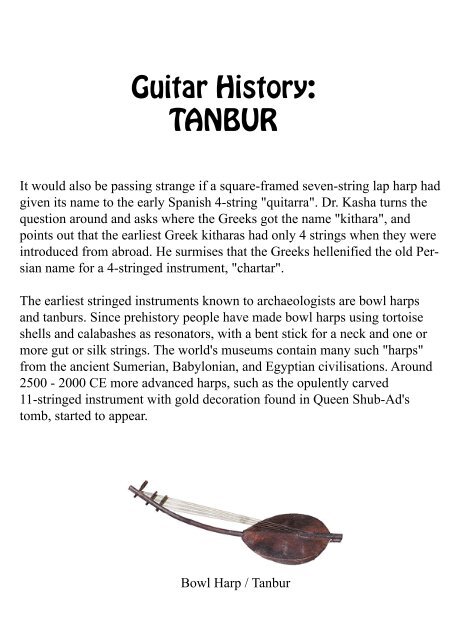2) pdf Mohamad Al Syariq Bin Md Wahit Hasim
Guitar History: TANBUR It would also be passing strange if a square-framed seven-string lap harp had given its name to the early Spanish 4-string "quitarra". Dr. Kasha turns the question around and asks where the Greeks got the name "kithara", and points out that the earliest Greek kitharas had only 4 strings when they were introduced from abroad. He surmises that the Greeks hellenified the old Persian name for a 4-stringed instrument, "chartar". The earliest stringed instruments known to archaeologists are bowl harps and tanburs. Since prehistory people have made bowl harps using tortoise shells and calabashes as resonators, with a bent stick for a neck and one or more gut or silk strings. The world's museums contain many such "harps" from the ancient Sumerian, Babylonian, and Egyptian civilisations. Around 2500 - 2000 CE more advanced harps, such as the opulently carved 11-stringed instrument with gold decoration found in Queen Shub-Ad's tomb, started to appear. Bowl Harp / Tanbur
A tanbur is defined as "a long-necked stringed instrument with a small eggor pear-shaped body, with an arched or round back, usually with a soundboard of wood or hide, and a long, straight neck". The tanbur probably developed from the bowl harp as the neck was straightened out to allow the string/s to be pressed down to create more notes. Tomb paintings and stone carvings in Egypt testify to the fact that harps and tanburs (together with flutes and percussion instruments) were being played in ensemble 3500 - 4000 years ago. At 3500 years old, this is the ultimate vintage guitar (the picture below). It belonged to the Egyptian singer Har-Mose. He was buried with his tanbur close to the tomb of his employer, Sen-Mut, architect to Queen Hatshepsut, who was crowned in 1503 BCE. Sen-Mut (who, it is suspected, was far more than just chief minister and architect to the queen) built Hatshepsuts beautiful mortuary temple, which stands on the banks of the Nile to this day. The Oldest Guitar. Har-Moses instrument
- Page 1 and 2: CLASSICAL guitar BEGINNER PACKAGE A
- Page 3: Series Editor: Rahman Dinedja Serie
- Page 7 and 8: CONTENTS INTRODUCTION 1 GUITAR : TA
- Page 9: line of development, sharing common
- Page 13 and 14: The name "guitar" comes from the an
- Page 15 and 16: The six-course arrangement graduall
- Page 17 and 18: At around the same time that Torres
- Page 19: THE GUITAR’S PART
- Page 23 and 24: Now pick a string, any string, and
Guitar History:<br />
TANBUR<br />
It would also be passing strange if a square-framed seven-string lap harp had<br />
given its name to the early Spanish 4-string "quitarra". Dr. Kasha turns the<br />
question around and asks where the Greeks got the name "kithara", and<br />
points out that the earliest Greek kitharas had only 4 strings when they were<br />
introduced from abroad. He surmises that the Greeks hellenified the old Persian<br />
name for a 4-stringed instrument, "chartar".<br />
The earliest stringed instruments known to archaeologists are bowl harps<br />
and tanburs. Since prehistory people have made bowl harps using tortoise<br />
shells and calabashes as resonators, with a bent stick for a neck and one or<br />
more gut or silk strings. The world's museums contain many such "harps"<br />
from the ancient Sumerian, Babylonian, and Egyptian civilisations. Around<br />
2500 - 2000 CE more advanced harps, such as the opulently carved<br />
11-stringed instrument with gold decoration found in Queen Shub-Ad's<br />
tomb, started to appear.<br />
Bowl Harp / Tanbur



